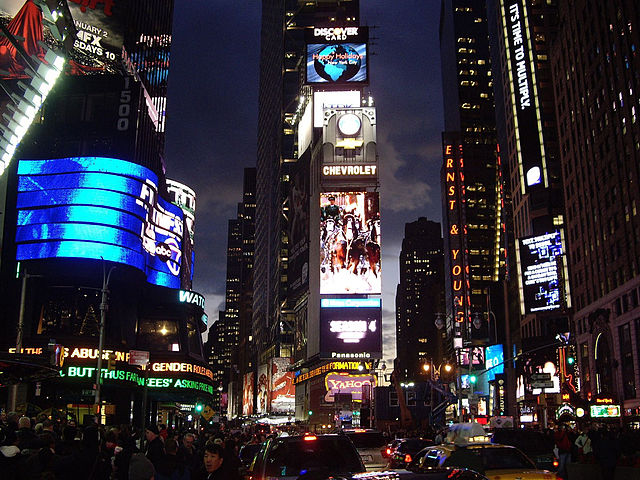Signs of the Times

Office space in Manhattan is pricey, to say the least. And for over a century, companies have been looking for ways to find more offices, even if it means building new buildings. On New Year’s Eve, 1903, the New York Times threw a midnight event at the site of its soon-to-open new headquarters, the Times Tower, located the intersections of Broadway (then Bloomingdale Road), Seventh Avenue, and 42nd Street in Manhattan — then called Longacre Square. The next April, Times publisher Adolph Ochs convinced the mayor, George B. McClellan, Jr., to rename the area “Times Square,” as it is called today. And for the next ten years, the Times would call One Times Square, pictured above, its home.
A century later, no one does. One Times Square’s office space is vacant, by design.
In 1913, the Times moved its headquarters to West 43rd Street, leaving behind a handful of offices in Times Square, and in 1961, the Times sold the building. Over the next century, the building would shed its original facade, as seen here, and transform into a concrete-and-marble canvas for the advertisements for which Times Square is now well known. And that advertising is worth a lot. In 2007, Reuters reported that One Times Square’s owners receives $20 million annually from the advertisers, and going up. There are 19 spots for ads, and just last year, at least two of the ad units were rented out for about $3.5 million a year — about the same price as a 30-second ad on the Super Bowl.
That money makes the building valuable, even if the office space is unoccupied. Which it is. While the retail space has Walgreens as a tenant (after years vacant but paid for, thanks to a broken lease by the Warner Bros. Studio Store which previously leased it), the 20-something stories above it are empty.
In 1996, real estate investment companies Jamestown Properties and Sherwood Equities purchased One Times Square, noting the unique value of its advertising space. The building’s interior had not been renovated in over thirty years, however, and was no longer up to code. Updating the wiring, heat, venting, air conditioning, and mechanics would be a costly investment. Further, because the building is on the intersection of three roadways, each floor is oddly shaped, resulting in very little floor space relative to typical office buildings. Finally, while the building was the second-tallest in Manhattan when it was constructed, at 395 feet, it is relatively short for a modern skyscraper — and its larger-than-average ceiling heights further reduce the amount of leasable floor space.
Taken as a whole, it made more sense to leave the building’s office space unoccupied than to ready it for rental.
Bonus fact: Every New Year’s Eve, a million or so people gather in Times Square and count down to the new year together as a ball, now made of crystal triangles, descends down the flagpole of One Times Square. This tradition began with the Times’ party in 1903 (which attracted 200,000 people) but didn’t involve the ball yet — that was added in 1908 — and (except for 1942 and 1943, to conserve energy to support the wartime efforts) has occurred since. But where did the idea come from? According to TIME, ball drops were commonplace in the U.S. — not for New Year’s, but hourly, as a way to keep everyone on schedule: “For decades, residents of U.S. cities would synchronize their pocketwatches using a giant globe that would descend from a pole in a public space to mark the exact hour.”
From the Archives: The President’s Secret Train Station: Just down 42nd Street from Times Square and up a few blocks is another hidden piece of New York City.
Related: Times Square as a 1000-piece puzzle.
